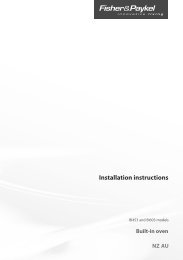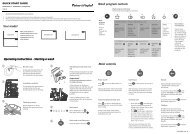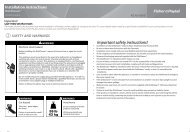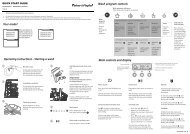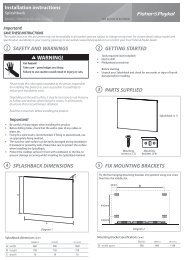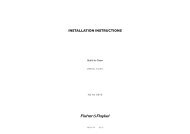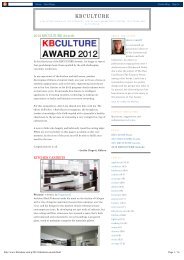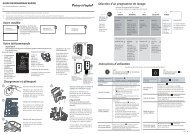usr guide ob60sl7 aa gb fp - Fisher & Paykel
usr guide ob60sl7 aa gb fp - Fisher & Paykel
usr guide ob60sl7 aa gb fp - Fisher & Paykel
You also want an ePaper? Increase the reach of your titles
YUMPU automatically turns print PDFs into web optimized ePapers that Google loves.
Built-in Oven<br />
OB60SL7 models<br />
User <strong>guide</strong><br />
NZ AU GB IE
Contents<br />
Safety and warnings 3<br />
Introduction 12<br />
The control panel 13<br />
First use 14<br />
Using the timer 16<br />
Cooking <strong>guide</strong> 18<br />
Oven functions 20<br />
Cooking charts 24<br />
Automatic cooking 30<br />
Care and cleaning 34<br />
Troubleshooting 48<br />
Warranty and service 50<br />
Important!<br />
SAVE THESE INSTRUCTIONS<br />
The models shown in this user <strong>guide</strong> may not be available in all markets and are<br />
subject to change at any time. For current details about model and specification<br />
availability in your country, please visit our website listed on the back cover<br />
or contact your local <strong>Fisher</strong> & <strong>Paykel</strong> dealer.<br />
1
Safety and warnings<br />
Your oven has been carefully designed to operate safely during normal cooking procedures.<br />
Please keep the following safety instructions in mind when you are using it:<br />
WARNING!<br />
Electrical Shock Hazard<br />
Turn the oven off at the wall before<br />
replacing the oven lamp.<br />
Failure to follow this advice may result<br />
in death or electrical shock.<br />
3
4 Safety and warnings<br />
WARNING!<br />
Fire Hazard<br />
Do not place aluminium foil, dishes,<br />
trays, water or ice on the oven floor<br />
during cooking, as doing so will<br />
irreversibly damage the enamel; lining<br />
the oven with aluminium foil may even<br />
cause fire.<br />
Never use your appliance for warming<br />
or heating the room. Persons could be<br />
burned or injured or a fire could start.<br />
Storage in or on appliance: flammable<br />
materials should not be stored in an<br />
oven or near its surface.<br />
Failure to follow this advice may result<br />
in overheating, burning, and injury.
WARNING!<br />
Safety and warnings<br />
Hot Surface Hazard<br />
Accessible parts may become hot when<br />
in use.<br />
To avoid burns and scalds, keep children<br />
away.<br />
Use oven mitts or other protection<br />
when handling hot surfaces such as<br />
oven<br />
shelves or dishes.<br />
Use care when opening the oven door.<br />
Let hot air or steam escape before<br />
removing or replacing food.<br />
Do not touch heating elements or<br />
interior surfaces of the oven. Heating<br />
elements may be hot even though they<br />
are dark in colour. Interior surfaces<br />
of an oven become hot enough to cause<br />
burns. During and after use, do not<br />
touch, or let clothing or other<br />
flammable materials contact heating<br />
elements or interior surfaces of the oven<br />
until they have had sufficient time to<br />
cool.<br />
Other surfaces of the appliance may<br />
become hot enough to cause burns -<br />
among these surfaces are the oven vent,<br />
the surface near the oven vent, and<br />
the oven door.<br />
Failure to follow this advice could result<br />
in burns and scalds.<br />
5
6 Safety and warnings<br />
WARNING!<br />
Cut Hazard<br />
Take care - some edges are sharp.<br />
Failure to use caution could result in<br />
injury or cuts.
Important safety instructions<br />
Safety and warnings<br />
To reduce the risk of fire, electrical shock, injury<br />
to persons or damage when using the oven,<br />
follow the important safety instructions listed<br />
below:<br />
Read all the instructions before using the oven.<br />
Use the oven only for its intended purpose as<br />
described in these instructions.<br />
Proper installation: be sure your appliance is<br />
properly installed and earthed by a qualified<br />
technician.<br />
Isolating switch: make sure this oven is<br />
connected to a circuit which incorporates an<br />
isolating switch providing full disconnection<br />
from the power supply.<br />
Household appliances are not intended to be<br />
played with by children.<br />
Do not leave children alone. Children should<br />
not be left alone or unattended in the area<br />
where the appliance is in use. They should never<br />
be allowed to sit or stand on any part of the<br />
appliance.<br />
7
8 Safety and warnings<br />
Important safety instructions<br />
Children of less than 8 years old must be kept<br />
away from the appliance unless continuously<br />
supervised. This appliance can be used by<br />
children aged from 8 years and above, and<br />
persons with reduced physical, sensory or<br />
mental capabilities or lack of experience and<br />
knowledge, if they have been given supervision<br />
or instruction concerning the use of the<br />
appliance in a safe way and they understand<br />
the hazards involved. Cleaning and user<br />
maintenance shall not be done by children<br />
without supervision.<br />
Do not place heavy objects on the oven door.<br />
Wear proper apparel. Do not wear loose fitting<br />
or hanging garments when using the appliance.<br />
They could ignite or melt if they touch an<br />
element or hot surface and you could be burned.<br />
User servicing: do not repair or replace any<br />
part of the appliance unless specifically<br />
recommended in the manual. All other servicing<br />
should be referred to a qualified technician.<br />
Do not use water on grease fires. Smother the<br />
fire or flame or use a dry chemical or foam type<br />
extinguisher.
Important safety instructions<br />
Safety and warnings<br />
Use only dry oven mitts or potholders. Moist or<br />
damp potholders on hot surfaces could result in<br />
burns from steam. Do not let potholders touch<br />
hot areas or heating elements. Do not use a<br />
towel or a bulky cloth for a potholder. It could<br />
catch fire.<br />
Do not heat unopened food containers. They can<br />
build up pressure that may cause the container<br />
to burst and result in injury.<br />
Safe food handling: leave food in the oven for<br />
as short a time as possible before and after<br />
cooking. This is to avoid contamination by<br />
organisms which may cause food poisoning.<br />
Take particular care during warm weather.<br />
Always keep oven vents unobstructed.<br />
Do not operate your appliance by means of<br />
an external timer or separate remote-control<br />
system.<br />
9
10 Safety and warnings<br />
Important safety instructions<br />
Caution: Hot air can blow from the vent at the<br />
top of the oven as part of the oven’s cooling<br />
system.<br />
Placement of oven shelves: always position<br />
shelves in the desired location while the oven<br />
is cool (before preheating). If a shelf must be<br />
removed while the oven is hot, do not let the<br />
oven mitts or potholder contact hot heating<br />
elements in the oven or the base of the oven.<br />
Do not clean the oven seal or use any ovencleaning<br />
products on it. It is essential for a good<br />
seal, which ensures that the oven operates<br />
efficiently. Care should be taken not to rub,<br />
damage or move it.<br />
Do not use oven cleaners, harsh/abrasive<br />
cleaning agents, waxes, or polishes. No<br />
commercial oven cleaner, oven liner, or<br />
protective coating of any kind should be used<br />
in or around any part of the oven. Do not use<br />
harsh/abrasive cleaners, scourers or sharp metal<br />
scrapers to clean the oven door glass since they<br />
scratch the surface, which may result in the glass<br />
shattering.<br />
Clean only the parts listed in this manual.
Important safety instructions<br />
Safety and warnings<br />
Do not use a steam cleaner to clean any part of<br />
the oven.<br />
Do not store things children might want above<br />
the oven. Children could be burned or injured<br />
while climbing on the oven to retrieve items.<br />
Do not install or operate the appliance if it is<br />
damaged or not working properly. If you receive<br />
a damaged product, contact your dealer or<br />
installer immediately.<br />
Use only bakeware approved for oven<br />
use. Follow the bakeware manufacturer’s<br />
instructions.<br />
11
12<br />
Introduction<br />
Congratulations on your new purchase. Your <strong>Fisher</strong> & <strong>Paykel</strong> oven has a number of features to<br />
make cooking a great experience for you:<br />
a wide choice of oven functions<br />
intuitive controls and displays<br />
Before you start<br />
Make sure the installer has completed the ‘Final checklist’ in the Installation instructions.<br />
Read this <strong>guide</strong>, taking special note of the ‘Safety and warnings’ section.<br />
Remove all packaging and dispose of it responsibly. Make sure all cable ties used to<br />
secure the shelves during shipping have been removed. Recycle items that you can<br />
Check that you have all the accessories listed below.<br />
3<br />
4<br />
5<br />
6<br />
7<br />
1 Control panel<br />
2 Oven vent louvres<br />
3 Step down oven wire shelf<br />
4 Oven light<br />
5 Telescopic sliding shelf<br />
(purchased separately)<br />
6 Side rack<br />
7 Oven wire shelf<br />
8 Oven door and handle<br />
9 Oven seal<br />
2<br />
8<br />
1<br />
9<br />
Accessories:<br />
10 Grill rack<br />
11 Smokeless grill tray<br />
(purchased separately)<br />
12 Deep Roasting dish<br />
13 Flat baking tray<br />
10<br />
11<br />
12<br />
13
A<br />
Display<br />
Automatic cooking<br />
stop indicator<br />
if lit:<br />
Automatic cooking<br />
stop time is set<br />
(see ‘Automatic cooking’)<br />
Touch controls<br />
Timer<br />
control<br />
Cooking time<br />
control<br />
Using the touch controls<br />
Use the ball of your finger, not its tip. The controls respond<br />
to touch, so you don’t need to apply any pressure.<br />
A<br />
Cooking time indicator<br />
The control panel<br />
Function<br />
dial<br />
if lit:<br />
Automatic cooking is set<br />
(see ‘Automatic cooking’)<br />
Stop time<br />
control<br />
- and +<br />
controls<br />
13<br />
Temperature<br />
dial<br />
Temperature indicator<br />
if lit:<br />
oven is pre-heating<br />
Timer indicator<br />
if lit:<br />
Timer is counting down
14 First use<br />
Setting the Clock<br />
Important!<br />
The clock needs to be set before you can use your oven.<br />
1 When the power to the oven is turned on<br />
or restored after a power failure,<br />
0 . 00 will flash in the display.<br />
3 Touch the cooking time and<br />
stop time controls together for 2<br />
seconds to accept the time.<br />
the display will stop flashing<br />
the oven will beep to confirm the time<br />
is set.<br />
Remove all cable ties and packaging<br />
Important!<br />
Before using your oven for the first time, remove<br />
all cable ties and internal packaging holding the<br />
shelving in place if the installer has not done so.<br />
If you have catalytic panels (purchased separately)<br />
you need to fit them before using the oven.<br />
See ‘Care and Cleaning’ for instructions on how to<br />
fit them.<br />
We recommend you then condition the oven.<br />
2 Touch the - or + controls to set the time.<br />
To Change the Time<br />
4a Touch the cooking time and stop time<br />
controls together for 2 seconds.<br />
The centre dot will flash.<br />
4b Touch the - and + controls to set the<br />
new time.<br />
4c Touch the cooking time and stop time<br />
controls together again for 2 seconds<br />
to accept the new time.<br />
the centre dot will stop flashing<br />
the oven will beep to confirm the new<br />
time is set.
Condition the oven<br />
First use<br />
It is important to condition your oven before using it for cooking and baking. Conditioning will<br />
burn off any manufacturing residues and ensure that you get the best results right from the start.<br />
1 Make sure you have removed ALL the cable ties used to secure the shelving during transit.<br />
2 Make sure you have set the clock.<br />
3 Make sure all the shelves are fitted.<br />
4 Select the Bake function.<br />
The oven will come on.<br />
6 After 30 minutes is up,<br />
select the Fan Grill function.<br />
After 20 minutes, switch the oven off.<br />
15<br />
5 Set the temperature to 200 o C for 30<br />
minutes.<br />
While the oven is heating up, the<br />
temperature indicator light will glow.<br />
When the oven has reached set<br />
temperature, the temperature indicator<br />
light will go out.<br />
Note: if the clock has not been set, the<br />
cooling fans will come on, but the oven light<br />
will not come on and the oven will not heat<br />
up.<br />
There will be a distinctive smell and<br />
a small amount of smoke during the<br />
conditioning process as manufacturing<br />
residue is burnt off. This is normal, but<br />
make sure the kitchen is well ventilated<br />
while the oven is conditioning.<br />
Once cooled, wipe out the oven with a<br />
damp cloth and mild detergent, and dry<br />
thoroughly.
16 Using the timer<br />
You can use the timer at any time, even if you are not using the oven.<br />
The time counts down in minutes (hours:min) until the last 5 minutes of cooking, when it will<br />
countdown in seconds (min:sec).<br />
You can set the timer for up to 4 hours.<br />
Important!<br />
The timer does NOT turn the oven off.<br />
1 Check the display shows the correct<br />
time of day.<br />
3 Touch the - and + controls to set the<br />
time.<br />
4 Touch the timer control to set<br />
the timer or wait 5 seconds and the<br />
display will show the time of day and<br />
the timer indicator .<br />
2 Touch the timer control.<br />
the display will show 0 . 00<br />
the timer indicator and dot will<br />
flash.<br />
5 To check the time remaining time:<br />
Touch the timer control.<br />
During the last 5 minutes of the<br />
countdown the display will show the<br />
time remaining.
To cancel the timer<br />
1 Touch the timer control to show<br />
the remaining time.<br />
2 Either:<br />
Touch the - control and scroll the<br />
time down to 0 . 00 or<br />
Touch and hold the - and + controls<br />
together until the display shows<br />
0 . 00.<br />
3 the timer indicator and display will<br />
flash for a few seconds and then<br />
return to the time of day.<br />
Using the timer<br />
17<br />
At the end of the countdown<br />
The timer will ‘beep’ every 7 seconds.<br />
The timer indicator will flash.<br />
The display will show 0 . 00.<br />
To cancel the beeping and return to<br />
the time of day, touch any control.
18<br />
General <strong>guide</strong>lines<br />
This oven has been designed to utilise its four elements and rear fan in differing combinations to<br />
provide you with enhanced performance and a wide range of functions, allowing you to cook all<br />
types of food to perfection.<br />
Outer<br />
Element Shelf positions<br />
Inner<br />
Element<br />
Fan<br />
Rear<br />
Element<br />
(concealed)<br />
Lower<br />
Element<br />
(concealed)<br />
Cooking <strong>guide</strong><br />
BAKING<br />
For best results when baking, always pre heat your oven. The temperature indicator will go out<br />
when the pre-set temperature is reached.<br />
Do not open the door until at least ¾ of the way through cooking.<br />
Make sure cake pans do not touch each other or the sides of the oven.<br />
When baking double the recipe (especially cookies) you may need to increase the time by a<br />
couple of minutes.<br />
Your cookware will influence baking times. Dark pans absorb the heat more quickly than<br />
reflective pans; glass cookware may require a lower temperature<br />
Multi-shelf baking may also require a slight increase in cooking time.<br />
Always leave a space between shelves when multi-shelf cooking to allow the air to circulate.<br />
Shelf Position Guide<br />
Place your baking on a shelf that will have the top of your pan near the centre of the oven cavity.<br />
6<br />
5<br />
4<br />
3<br />
2<br />
1
Cooking <strong>guide</strong><br />
ROASTING<br />
Use Fan Grill to roast whole chicken.<br />
For other meats use Bake for a succulent juicy flavoursome roast.<br />
Boneless, rolled or stuffed roasts take longer than roasts containing bones.<br />
Poultry should be well cooked with the juices running clear and an internal temperature of 75°C.<br />
For crispy crackling first sear the Pork at a high temperature, then lower the temperature to<br />
complete the cooking.<br />
If multi-shelf cooking (eg if roasting meat on one shelf and vegetables on another) use Fan<br />
Forced.<br />
Cook larger cuts of meat for longer at a lower temperature. The meat will cook more evenly.<br />
Always roast meat fat side up. That way, basting may not be required.<br />
Always rest the meat for at least 10 minutes after roasting to allow the juices to settle. Remember<br />
the meat will continue to cook for a few minutes after removing it from the oven.<br />
Shelf Position Guide<br />
Place the meat on a shelf so that the meat is in the centre of the oven or lower.<br />
GRILLING<br />
This is a healthier alternative to frying.<br />
Always grill with the oven door completely shut.<br />
If you use glass or ceramic pans, be sure they can withstand the high temperatures of the grill.<br />
To avoid piercing the meat and letting juices escape, use tongs or a spatula to turn the meat<br />
halfway through cooking.<br />
Brush meat with a little oil to help keep the meat moist during cooking. Alternatively marinade<br />
the meat before grilling (but be aware that some marinades may burn easily).<br />
Where possible grill cuts of meat of a similar thickness at the same time. This will ensure even<br />
cooking.<br />
Always keep a close watch on your food while grilling to avoid charring or burning<br />
Shelf Position Guide<br />
For thinner cuts of meat, toasting or browning foods, use a higher shelf position.<br />
Thicker cuts of meats should be grilled on lower shelves or at a lower grill setting to ensure even<br />
cooking.<br />
REHEATING<br />
Use Bake or Fan Bake to reheat food.<br />
Always reheat food to piping hot. This reduces the risk of contamination by harmful bacteria.<br />
Never reheat a food more than once.<br />
19
20<br />
Oven functions<br />
Bake<br />
upper outer and lower elements<br />
Heat comes from both the upper and lower elements. The fan is not used in this function.<br />
Ideal for cakes and foods that require baking for a long time or at low temperatures.<br />
This function is not suitable for multi-shelf cooking.<br />
Ideal for moist foods that take a longer time to cook eg rich fruit cake.<br />
Fan Bake<br />
fan plus upper outer and lower elements<br />
The oven fan circulates hot air from the top outer and the lower elements and distributes it<br />
around the oven cavity.<br />
Food cooked tends to brown more quickly than foods cooked on the traditional Bake function.<br />
You may need to decrease the time from that recommended in traditional recipes.<br />
Use Fan Bake at a low temperature eg 50°C for drying fruit, vegetables and herbs.<br />
Ideal for single shelf baking that takes less than an hour to cook – foods such as muffins, scones and<br />
cupcakes or things like enchiladas.
fan and rear element<br />
Fan Forced<br />
Oven functions<br />
By using the central rear heating element and fan, hot air is blown into the cavity, providing a<br />
consistent temperature at all levels, making it perfect for multi-shelf cooking.<br />
Trays of cookies cooked on different shelves are crisp on the outside and chewy in the middle.<br />
Meat and poultry are deliciously browned and sizzling while remaining juicy and tender.<br />
Casseroles are cooked to perfection and reheating is quick and efficient.<br />
When multi-shelf cooking it is important to leave a gap between trays (eg use shelves 3 & 5) to<br />
allow the air to move freely. This enables the browning of foods on the lower tray.<br />
If converting a recipe from Bake to Fan Forced, we recommend that you decrease the bake time<br />
or decrease the temperature by approximately 20°C.<br />
For items with longer bake times (eg over an hour) it may be necessary to decrease both time<br />
and temperature.<br />
Ideal for multi-shelf cooking biscuits, cookies, scones, muffins and cupcakes.<br />
Fan Grill<br />
fan plus upper inner and outer elements<br />
This function uses the intense heat from the upper elements for top browning and the fan to<br />
ensure even cooking of foods.<br />
Meat, poultry and vegetables cook beautifully; food is crisp and brown on the outside while the<br />
inside remains moist and tender.<br />
Ideal for whole chicken, tenderloin of beef or grilling your favourite chicken, fish and steak.<br />
21
22 Oven functions<br />
fan plus lower element<br />
Pastry Bake<br />
The fan circulates heat from the lower element throughout the oven.<br />
Excellent for cooking pizza as it crisps the base beautifully without overcooking the topping.<br />
Ideal for foods such as sweet and savoury pastry foods and delicate foods that require some top<br />
browning eg frittata, quiche.<br />
lower element only<br />
Classic Bake<br />
Heat comes from the lower element only, the fan is not used.<br />
This is the traditional baking function, suitable for recipes that were developed in older ovens.<br />
Bake on only one shelf at a time.<br />
The oven will be hotter at the top.<br />
Ideal for foods that require delicate baking and have a pastry base, like custard tarts, pies, quiches<br />
and cheesecake or anything that does not require direct heat and browning on the top.<br />
Proving bread<br />
This function is perfect for proving bread dough.<br />
Preheat the oven to 50 o C and then turn the oven off. The oven is well insulated and will stay<br />
warm for several hours.<br />
Place the dough in a lightly greased bowl and cover with a plastic wrap and/or a clean cloth.<br />
Place on the lowest shelf position and close the door.
Grill<br />
upper inner and outer elements<br />
Oven functions<br />
This function delivers intense radiant heat from both top elements. You can set the intensity of<br />
the heat by altering the temperature setting.<br />
Preheating is not essential although some people prefer to allow the element to heat for a few<br />
minutes before they place food under the grill.<br />
The most suitable function for ‘finishing off’ many meals, for example browning the top of potato<br />
gratin and frittata.<br />
Ideal for toasting bread or for top browning to ‘finish off dishes’.<br />
23
24 Cooking Charts<br />
Shelf positions are counted from the base up (1 is the lowest, 6 is the highest).<br />
Position shelves before you turn the oven on.<br />
For best results preheat the oven to the required temperature.<br />
The temperature indicator light will go out when the oven has reached the selected temperature.<br />
BAKING<br />
Food Shelves<br />
Plain<br />
Single<br />
Multi<br />
Biscuits<br />
Chewy choc chip<br />
Single<br />
Multi<br />
Oatmeal Single<br />
Slices / Squares Single<br />
Vanilla Single<br />
Butter / Chocolate Single<br />
Light fruit Single<br />
Cakes<br />
Rich fruit Single<br />
Sponge<br />
(single large)<br />
Single<br />
Sponge<br />
(two small pans)<br />
Single<br />
Shortbread Single<br />
Muffi ns / Cupcakes<br />
Single<br />
Multi<br />
Scones<br />
Single<br />
Multi<br />
Meringues Single<br />
Bread Rolls Single<br />
Phyllo Single<br />
Flaky/Puff Single<br />
Pastry<br />
Choux<br />
Single<br />
Multi<br />
Croissants<br />
Single<br />
Multi<br />
Pies<br />
Apple<br />
Lemon Meringue<br />
Single<br />
Single
Recommended<br />
Function<br />
Shelf<br />
positions<br />
Cooking Charts<br />
The information in these charts are <strong>guide</strong>lines only. Refer to your recipe or the packaging and be<br />
prepared to adjust the cooking times and settings accordingly.<br />
Temp (°C) Time (mins)<br />
Fan Bake 4 180-190 13-17<br />
Fan Forced 3 and 5 160-170 13-17<br />
Fan Bake 4 180-190 15-20<br />
Fan Forced 3 and 5 160-170 15-20<br />
Pastry Bake 4 160-170 12-15<br />
Pastry Bake 3 160-165 15-20<br />
Bake 4 160-165 30-35<br />
Bake 4 160-180 50-60<br />
Bake 2 155-165 1hr 30<br />
Classic Bake 2 120-160 2.5 hrs<br />
Bake 2 175 30-40<br />
Bake 2 170-190 15-25<br />
Pastry Bake 3 130-140 20-25<br />
Fan Bake 3 180-190 13-17<br />
Fan Forced 2 and 4 160-170 16-21<br />
Fan Bake 2 210-230 8-12<br />
Fan Forced 1 and 3 210-230 8-12<br />
Bake 1 100-120 60<br />
Bake 4 195-210 25-35<br />
Fan Bake 3 190-200 15-25<br />
Bake<br />
Bake<br />
3 185-200 20-30<br />
Fan Forced<br />
Bake<br />
2 200-210 30-35<br />
Fan Forced 3 190-200 15-25<br />
Pastry Bake 2 190-200 25-30<br />
Pastry Bake 2 175-180 30-40<br />
25
26 Cooking Charts<br />
SAVOURY<br />
ROASTING<br />
Food Shelves<br />
Pies Chicken / Steak / Mince Single<br />
Sausage Rolls Single<br />
Meat Loaf Single<br />
Pizza Single<br />
Lasagne Single<br />
Quiche Single<br />
Potatoes Traditional Baked Single<br />
Frittata Grill to fi nish Single<br />
Casseroles Single<br />
Oven meals Single<br />
Food Shelves<br />
Beef (Boneless)<br />
Rare<br />
Medium<br />
Well done<br />
Rare<br />
Single*<br />
Prime Rib Roast<br />
Medium<br />
Well done<br />
Single*<br />
Lamb leg (Bone in)<br />
Medium<br />
Well done<br />
Single*<br />
Lamb leg (Boneless)<br />
Medium<br />
Well done<br />
Single*<br />
Veal<br />
Medium<br />
Well done<br />
Single*<br />
Chicken (Whole) Single*<br />
Turkey (Whole)<br />
With Stuffi ng<br />
Without Stuffi ng<br />
Single*<br />
Pork (Boneless)<br />
Medium<br />
Well done<br />
Single*<br />
Pork Crackling Crisp<br />
Venison<br />
Brown in a frying<br />
pan fi rst.<br />
Rare<br />
Medium<br />
Single*<br />
* If multiple shelves are required (eg roasting vegetables at the same time), use Fan Forced and shelf positions 2 & 4.
Recommended<br />
Function<br />
Shelf<br />
positions<br />
Cooking Charts<br />
Temp (°C) Time (mins)<br />
Pastry Bake 3 190-195 30-40<br />
Pastry Bake 3 190-195 30-40<br />
Bake 4 175-180 55-65<br />
Bake 1 225-250 15-20<br />
Fan Bake 3 175-180 45-50<br />
Pastry Bake 2 180-200 30-40<br />
Bake 3 175-190 40-50<br />
Pastry Bake 3 170-180 30-45<br />
Bake 3 170-190 55-70<br />
Fan Forced 3 170-190 30-40<br />
Recommended<br />
Function<br />
Shelf<br />
positions<br />
Temp (°C) Time (mins)<br />
Bake 3 160-170 18-32 / 450g<br />
Bake 3 160-170 25-40 / 450g<br />
Bake 3 160-170 30-55 / 450g<br />
Bake 3 160-170 15-30 / 450g<br />
Bake 3 160-170 20-35 / 450g<br />
Bake 3 160-170 25-40 / 450g<br />
Bake 3 160-170 18-28 / 450<br />
Bake 3 160-170 20-33 / 450g<br />
Bake 3 160-170 20-35 / 450g<br />
Bake 3 160-170 25-45 / 450g<br />
Bake 3 160-170 20-40 / 450g<br />
Bake 3 160-170 25-45 / 450g<br />
Fan Grill 2 175-190 15-20 / 450G<br />
Bake 1 165-175 17-22 / 450g<br />
Bake 1 150-165 15-20 / 450g<br />
Bake 3 170-175 25-40 / 450g<br />
Bake 3 170-175 30-45 / 450g<br />
Bake 3 250 20<br />
Fan Grill 4 225<br />
7 ½ / 2.5cm meat<br />
thickness<br />
Fan Grill 4 225<br />
9 ½ / 2.5cm meat<br />
thickness<br />
27
28 Cooking Charts<br />
GRILLING<br />
Beef<br />
Food Shelves<br />
Steak<br />
Rare<br />
Medium<br />
Single<br />
Single<br />
Burgers Single<br />
Meatballs Single<br />
Lamb Chops<br />
Medium<br />
Well done<br />
Single<br />
Single<br />
Chops (well done) Single<br />
Pork<br />
Ham steak Single<br />
Bacon Single<br />
Chicken Boneless pieces Single<br />
Sausages Single<br />
Fish<br />
Fillets<br />
Whole<br />
Single<br />
Single<br />
Vegetables Sliced Single
Recommended<br />
Function<br />
Shelf<br />
positions<br />
Cooking Charts<br />
Temp (°C) Time (mins)<br />
Grill 4 250 8-10<br />
Grill 4 250 10-15<br />
Grill 4 250 12-15<br />
Grill 4 250 12-15<br />
Grill 4 250 15-20<br />
Grill 4 250 20-25<br />
Grill 4 250 15-20<br />
Grill 4 250 15-20<br />
Grill 4 250 4-7<br />
Fan Grill 5 175-190 30-50<br />
Grill 5 250 10-15<br />
Fan Grill 5 200-220 8-12<br />
Fan Grill 5 200-220 15-20<br />
Grill 4 250 8-12<br />
29
30<br />
Automatic cooking<br />
You can set the oven to automatically turn on later, cook for a preset time (cooking time), then<br />
automatically turn off at a preset stop time. See the example and instructions below (steps 1 to 7).<br />
If you start cooking manually and only want the oven to turn off automatically after a set<br />
cooking time: simply set the cooking time following steps 1 to 4 below and select a function and<br />
temperature. The oven will automatically turn off when the cooking time is over.<br />
Alternatively you may set the time of day you wish the oven to turn off. Follow steps 5-7.<br />
You may still use the timer when using automatic cooking.<br />
Important!<br />
Safe food handling: leave food in the oven for as short a time as possible before and after cooking or<br />
defrosting. This is to avoid contamination by organisms which may cause food poisoning. Take particular<br />
care during warmer weather.<br />
Example: It is 11:05 a.m. You want your food to cook for 1 hour, and you would like it to be ready<br />
by lunchtime (12:30 p.m.)<br />
Set the cooking time<br />
1 Check the clock shows the correct time<br />
of day.<br />
3 Touch the - and + controls to set<br />
the cooking time. Make sure you<br />
allow for preheat time in your<br />
calculation.<br />
2 Touch the cooking time control.<br />
The cooking time indicator will flash.<br />
4 Touch the cooking time control to<br />
confirm.<br />
The cooking time indicator will stop<br />
flashing and remain on.
A A<br />
A<br />
Set the stop time<br />
5 Touch the stop time control.<br />
The stop time A indicator will flash.<br />
7 Touch the stop time control to confirm.<br />
The A will stop flashing and remain on<br />
and the display will show the time of day.<br />
Automatic cooking<br />
31<br />
6 Touch the - and + controls to set the time<br />
you would like your food to be ready by<br />
(ie the stop time).
32 Automatic cooking<br />
Select function and temperature<br />
8 Select a function.<br />
The oven will come on.<br />
Note: if you have set the oven to<br />
automatically turn on later, the oven<br />
cooling fan will come on when you select<br />
a function, but the light will be off and the<br />
oven will not heat up.<br />
9 Set the temperature.
Automatic cooking<br />
When automatic cooking is set<br />
The oven lights will stay off but your oven is now set for automatic cooking. It will automatically<br />
heat up at the required time.<br />
The display will show the time of day with the cooking time and stop time A indicators lit.<br />
The cooling fan will continue to run.<br />
Note: you can modify the function and temperature before and during cooking.<br />
To check the set cooking time<br />
Touch the cooking time control.<br />
To modify the set cooking time<br />
Touch the cooking time control. The cooking time indicator will flash.<br />
You can modify the set cooking time by using the - and + controls. Touch the cooking time<br />
control again to set.<br />
To cancel the Cooking time<br />
Touch the stop time control. Touch the - control and scroll the time down to 0 . 00<br />
Touch the cooking time control to accept.<br />
Note: this will not turn off the oven. If the stop time is set the oven will turn off when the stop<br />
time is reached.<br />
To check the stop time<br />
Touch the stop time control.<br />
To modify the stop time<br />
Touch the stop time control. The stop time A indicator and dot will flash.<br />
You can modify the set cooking time by using the - and + controls. Touch the stop time<br />
control again to set.<br />
Scrolling the time down will not turn off the oven.<br />
To cancel automatic cooking<br />
Touch the cooking time control and the stop time control together for two seconds.<br />
Turn the function and temperature dials to O Off<br />
When the stop time is reached<br />
The oven will automatically turn off and the oven will beep every 7 seconds.<br />
The cooking time and the stop time A indicator will flash.<br />
Turn the function and temperature dials back to O Off.<br />
Press any control to exit automatic cooking.<br />
Note: if the oven function dial has not been turned back to O Off when you exit automatic<br />
cooking, the oven will turn back on.<br />
33
34<br />
Care and cleaning<br />
Manual cleaning<br />
ALWAYS NEVER<br />
Before any manual cleaning or<br />
maintenance, first wait for the oven to cool<br />
down to a safe temperature to touch, then<br />
turn its power supply off at the wall.<br />
Read these cleaning instructions and the<br />
‘Safety and warnings’ section before you<br />
start cleaning your oven.<br />
To prevent soiling from becoming ‘baked<br />
on’ and stubborn, we recommend removing<br />
any easy-to-reach spills, food or grease<br />
stains from the oven cavity enamel after<br />
each use.<br />
Never use a steam cleaner.<br />
Never store flammable substances in the<br />
oven.<br />
Never use abrasive or harsh cleaners,<br />
cloths, scouring pads or steel wool. Some<br />
nylon scourers may also scratch. Check the<br />
label first.<br />
Never use oven cleaner on catalytic panels<br />
(purchased separately).<br />
Never leave alkaline (salty spills) or acidic<br />
substances (such as lemon juice or vinegar)<br />
on the oven surfaces.<br />
Never use cleaning products with a chlorine<br />
or acidic base.
Care and cleaning<br />
What? How? Important!<br />
Glass surfaces<br />
(oven door<br />
panes,<br />
control panel)<br />
Door comprises a total of 3 glass panes<br />
C<br />
B<br />
A<br />
inner<br />
middle<br />
outer<br />
To clean glass pane B, you will<br />
first need to remove the door and the<br />
inner pane. For instructions, see section<br />
‘Removing and replacing the door<br />
glass panes for cleaning’.<br />
1 Clean with a solution of mild<br />
detergent or baking soda and hot<br />
water, then wipe dry.<br />
2 Wipe with a glass cleaner and dry<br />
with a soft, lint-free cloth.<br />
35<br />
Don’t use oven cleaners or any<br />
other harsh/abrasive cleaners,<br />
cloths, scouring pads, steel<br />
wool or sharp metal scrapers<br />
to clean the glass surfaces.<br />
These scratch the glass and<br />
may damage its special<br />
coating, which in turn could<br />
result in the glass cracking or<br />
shattering.<br />
Even if you only clean the inner<br />
pane (C), remove the door<br />
and the pane first. Cleaning<br />
the glass with the pane in the<br />
door may result in cleaning<br />
liquid running down the gaps<br />
and drying onto internal<br />
components.<br />
Take particular care when<br />
cleaning the control panel<br />
glass.
36 Care and cleaning<br />
Manual cleaning<br />
What? How? Important!<br />
Dials Clean with a solution of mild detergent<br />
and hot water, then wipe dry.<br />
Stainless steel<br />
strip/handle<br />
on the front<br />
of the oven<br />
door<br />
Aluminium<br />
framing of<br />
oven door<br />
and plastic<br />
corner clips<br />
Catalytic<br />
panels<br />
(purchased<br />
separately)<br />
Clean with a solution of mild<br />
detergent and hot water, then wipe<br />
dry with a microfibre cloth.<br />
If necessary, use a suitable stainless<br />
steel cleaner and polish.<br />
Clean with a solution of mild detergent<br />
and hot water, then wipe dry.<br />
To clean light soiling off the surfaces:<br />
1 Wipe with a damp cloth and a<br />
solution of hot water and mild<br />
detergent or an ammonia-based<br />
cleaner.<br />
2 Wipe dry with a soft cloth.<br />
To clean stubborn, ‘baked on’ soiling<br />
run the oven on Fan Grill at 200°C for<br />
1.5 hours to enhance the catalytic<br />
panel cleaning function.<br />
Do not use stainless steel or oven<br />
cleaner on the dials, as doing so<br />
may damage their coating.<br />
Always read the label to make<br />
sure that your stainless steel<br />
cleaner does not contain<br />
chlorine compounds as these<br />
are corrosive and may damage<br />
the appearance of your oven.<br />
Always rub the stainless steel<br />
in the direction of the grain.<br />
These panels are normally<br />
‘self-cleaning’ because their<br />
special enamel breaks down<br />
greasy splatters when the<br />
oven is used for ‘non-greasy’<br />
baking, especially at high<br />
temperatures.<br />
Do not use oven cleaner on the<br />
catalytic panels. If you wish to<br />
use oven cleaner on any other<br />
part of the enamelled cavity,<br />
first remove the catalytic<br />
panels.<br />
Do not immerse catalytic<br />
panels in water.<br />
Never use scourers, brushes,<br />
abrasives or cleaners with<br />
acid or alkali content on the<br />
catalytic panels.
Manual cleaning<br />
Care and cleaning<br />
What? How? Important!<br />
Oven cavity Remove everything from the oven:<br />
all shelves and trays, the side racks,<br />
the catalytic panels (if purchased<br />
separately).<br />
1 Remove the oven door (see<br />
instructions on following pages).<br />
2 Wipe the inside of the oven using<br />
a household detergents or a<br />
commercial cleaner.<br />
3 Wipe clean with a damp cloth and<br />
allow to dry completely.<br />
Telescopic<br />
sliding<br />
shelves<br />
(purchased<br />
separately)<br />
Grill tray<br />
Grill rack<br />
Side racks<br />
Oven shelves<br />
Baking tray<br />
Oven seal<br />
Oven vent<br />
louvres<br />
Wipe with a damp cloth and mild<br />
detergent. Do not wipe off or wash<br />
away the white lubricating grease<br />
(visible when the slides are<br />
extended).<br />
Clean with a solution of mild<br />
detergent and hot water.<br />
Pre-soak stubborn burnt-on stains in<br />
a solution of dishwasher powder and<br />
hot water..<br />
Except for the baking tray, these<br />
parts are also dishwasher safe.<br />
(Washing the baking tray in the<br />
dishwasher may degrade its surface)<br />
37<br />
To prevent soiling from<br />
becoming ‘baked on’ and<br />
stubborn, we recommend<br />
removing any easy-to-reach<br />
spills, food or grease stains<br />
from the enamelled surfaces<br />
after each use.<br />
To make wiping out the oven<br />
easier you may remove and the<br />
oven door. See the following<br />
pages for instructions.<br />
To make cleaning the oven<br />
ceiling easier, the upper<br />
element can be lowered.<br />
See following pages for<br />
instructions.<br />
Do not wash these in the<br />
dishwasher, immerse in soapy<br />
water or use oven cleaner on them.<br />
Doing so will remove the white<br />
lubricating grease and prevent the<br />
slides from running smoothly.<br />
Do not clean this part.<br />
Wipe with a damp cloth. Take care not to let any liquid run<br />
down the louvres of the oven vent.
38 Care and cleaning<br />
Removing and replacing the side racks to clean behind or fit catalytic panels*<br />
(purchased separately)<br />
Important!<br />
Always turn off the oven at the wall first. Ensure the oven has cooled down completely before starting.<br />
Remove all the shelves<br />
1 Remove all the shelving, taking special care with the telescopic sliding shelves.<br />
2 To remove a telescopic sliding shelf*, grip it at the front (making sure you are gripping the wire<br />
shelf and the sliding frame together), lift upwards and pull it out of the oven.<br />
For your safety, the wire shelf and telescopic sliding frame are built together as one unit and are<br />
not separable.<br />
3 For easier access, we recommend removing the oven door. See ‘Removing and refitting the oven<br />
door.’<br />
* Purchased separately. Contact your authorised dealer, customer care or see our local website listed at the back of<br />
this document for details.<br />
Remove both side racks<br />
2<br />
retaining wire lock stud<br />
1<br />
3
Catalytic panel<br />
Fit both catalytic panels.<br />
Place each catalytic panel flush against<br />
the side wall, noting the position of the<br />
cutouts for the lamp and lock nuts.<br />
Shelf stop<br />
Stop Notch<br />
Replacing a wire shelf<br />
1<br />
Care and cleaning<br />
1<br />
2<br />
retaining wire<br />
lock stud<br />
Replace both side racks.<br />
To replace the side racks, locate the top of<br />
the side rack into the two upper lock studs<br />
and gently push the retaining wire back<br />
under the lower lock stud.<br />
Guard rail<br />
Replace shelving.<br />
To replace a wire shelf, check the guard rail (as shown) to make sure the shelf is the right way<br />
up. Slide it horizontally back along the side racks ensuring it is level and the stop notch is facing<br />
down.<br />
39
40 Care and cleaning<br />
Removing the catalytic panels (purchased separately)<br />
Remove the side racks as previously described, then pull the catalytic panel toward the centre of<br />
the oven, until clear of the lower locating nut.<br />
Catalytic panel
Drop-down upper element<br />
Care and cleaning<br />
Important!<br />
Always turn off the oven at the wall before lowering the upper element. Make sure the oven has cooled<br />
down completely before starting.<br />
To lower the upper element: use a flat-head screwdriver or a small coin to loosen the element<br />
fixing screw. The element will now drop down to enable cleaning.<br />
When you have finished cleaning the oven ceiling, raise the element and screw the element<br />
fixing screw back onto the stud. Make sure that the fixing screw is tightened and the element is<br />
held securely in place.<br />
The element itself is self-cleaning.<br />
Fixing screw<br />
Stud<br />
41
42 Care and cleaning<br />
Replacing the oven light bulb<br />
Note: Oven bulb replacement is not covered by your warranty.<br />
Your oven uses a screw-in incandescent OVEN bulb - it must be capable of withstanding high<br />
temperatures (300 o C) and with the specifications: 230-240V, 50Hz and 25W.<br />
The light is located in the ceiling of the oven, center front.<br />
Changing the bulb<br />
1 Let the oven cavity and grill element cool down before changing the bulb.<br />
Important!<br />
Turn the oven off at the wall before continuing.<br />
2 Turning anti-clockwise unscrew the glass cover (B).<br />
3 Carefully unscrew the faulty light bulb (A).<br />
4 Replace the light bulb (A)<br />
5 Replace the glass cover (B).<br />
6 Turn the oven back on and set the clock (see ‘First use’ for instructions).<br />
Glass cover (B)<br />
Light Bulb (A)
Removing and refitting the oven door<br />
Important!<br />
Take care, the oven door is heavy!<br />
To remove the door<br />
1 Open the door fully.<br />
3 Hold the door.<br />
5 Disengage the hinges and<br />
remove the door.<br />
C<br />
Care and cleaning<br />
2 Open the levers fully.<br />
4 Close the door until it connects<br />
with the top of both levers<br />
To refit the door<br />
Lever<br />
Repeat the steps in reverse order:<br />
1 Slide the hinges into the slots while lifting<br />
the door slightly to engage the hinge.<br />
2 Open the door fully.<br />
3 Close the levers fully. If the levers do not<br />
lie flat, reposition the door by opening the<br />
levers fully again and following steps 1-3.<br />
Important!<br />
Ensure the levers lie flat against the hinge<br />
before trying to shut the door.<br />
43
44 Care and cleaning<br />
Removing the door glass panes for cleaning<br />
Important!<br />
Make sure you follow the precautions and instructions below very carefully. Replacing the glass<br />
panes and the door incorrectly may result in damage to the oven and may void your warranty.<br />
Take care, the oven door is heavy (11 kg). If you have any doubts, do not attempt to remove the<br />
door.<br />
Make sure the oven and all its parts have cooled down. Do not attempt to handle the parts of a<br />
hot oven.<br />
Take extreme care when handling the glass panes. Avoid the corners and edges of the glass<br />
bumping against any surface. This may result in the glass shattering.<br />
Don’t use oven cleaners or any other harsh/abrasive cleaners, cloths, scouring pads, steel wool<br />
or sharp metal scrapers to clean the glass surfaces. These scratch the glass and may damage its<br />
special coating, which in turn could result in the glass cracking or shattering.<br />
If you notice any sign of damage on any of the glass panes (such as chipping or cracks), do not<br />
use the oven. Call your Authorised Repairer or Customer Care.<br />
Make sure you replace all the glass panes correctly. Do not use the oven without all glass panes<br />
correctly in place.<br />
If the glass panes feel difficult to remove or replace, do not force them. Call your Authorised<br />
Repairer or Customer Care for help. Note: service visits providing assistance with using or<br />
maintaining the oven are not covered by your warranty.<br />
We recommend removing the door to make cleaning the glass easier. See ‘Removing and<br />
refitting the oven door’ for instructions. Once the door is removed, lay it down on a soft, clean,<br />
flat surface.<br />
Make sure you follow the precautions and instructions below very carefully. Replacing the glass<br />
panes and the door incorrectly may result in damage to the oven and may void your warranty.
Remove the inner pane<br />
2<br />
1 Press in on both tabs to release the Glass<br />
retainers.<br />
2 Slide both Glass retainers away from the<br />
pane.<br />
Remove the middle pane<br />
Top<br />
Clamp<br />
1<br />
Glass retainer<br />
Tab<br />
5 Brace the top of the door against your<br />
body. Grasp both sides of the outer edges<br />
of the pane at the bottom of the door.<br />
6 Gently pull the pane toward the top of the<br />
door.<br />
7 When the pane is clear of the clamp at<br />
the bottom of the door, lift the the pane<br />
slightly.<br />
5<br />
7<br />
4<br />
Care and cleaning<br />
45<br />
3 Lift the top of the pane slightly.<br />
Note: Only lift the pane slightly. Angling<br />
the pane too much may result in damage<br />
to the glass.<br />
4 Slide the pane toward the top of the door<br />
and lift out.<br />
7<br />
3<br />
Important!<br />
Do not twist or rotate the pane as this may<br />
cause it to break. Only lift the pane slightly.<br />
Angling the pane too far may cause it to break.<br />
8 Slide the pane out of the top clamp and lift<br />
out.<br />
6<br />
Bottom<br />
Clamp
46 Care and cleaning<br />
After cleaning, replace the door glass panes<br />
When replacing the glass panes, make sure that:<br />
you replace all panes correctly, as shown. Each pane must be in the position described below in<br />
order to fit into the door and to ensure that the oven operates safely and correctly<br />
you take extra care not to bump the edges of the glass against any object or surface<br />
you do not force any of the panes into place. If you are experiencing difficulties replacing the<br />
panes, remove them and start the process again from the beginning. If this still does not help, call<br />
Customer Care.<br />
Replace the middle pane<br />
Top<br />
Clamp<br />
(lower<br />
notch)<br />
1 Insert the pane into the lower notch on<br />
the top clamps at the top of the door.<br />
2 Carefully pull the pane toward the top of<br />
the door.<br />
2<br />
1<br />
3 Slot the pane into the lower notch on<br />
the bottom clamps at the bottom of the<br />
drawer.<br />
3<br />
Bottom<br />
Clamp<br />
(lower<br />
notch)
Replace the inner pane<br />
5<br />
4a Ensure the pane is the right way up (ie the<br />
logo should be readable at the bottom of<br />
the door)<br />
4b Slide the pane into the upper notch on the<br />
bottom clamps at the bottom of the door.<br />
4<br />
6<br />
Care and cleaning<br />
Glass retainer<br />
Top Clamp<br />
(upper notch)<br />
Important!<br />
Make sure the glass retainers are correctly and firmly in place and that the glass panes are secure.<br />
47<br />
5 Lower the pane onto the upper notch on<br />
the top clamps at the top of the door.<br />
6 Slide the glass retainers back into position<br />
and ensure they have clipped securely in<br />
place.
48 Troubleshooting<br />
Troubleshooting chart<br />
If there is a problem, check the chart below to see if you can fix it. If the problem cannot be fixed<br />
or persists, call your Authorised Repairer or Customer Care.<br />
Problem<br />
General<br />
Possible causes What to do<br />
The oven does not work. No power. Check that the mains power<br />
supply (wall switch) is turned on<br />
and there is no power outage in<br />
your area.<br />
The oven does not work<br />
but the display is lit.<br />
The oven light does not<br />
come on when I select a<br />
function.<br />
The oven light does not<br />
come when I open the<br />
door.<br />
The oven is set for automatic<br />
cooking.<br />
The oven light bulb has<br />
blown.<br />
The clock has not been set<br />
See ‘Automatic cooking’ for<br />
information.<br />
Replace the light bulb. See<br />
‘Care and cleaning’ for<br />
instructions.<br />
See ‘First use’ for instructions on<br />
settng the clock.<br />
This is normal. The oven light only comes<br />
on when you have selected a<br />
cooking function.<br />
The oven is not heating. The door is not properly closed<br />
or it is opened too frequently<br />
during cooking.<br />
The clock has not been set.<br />
The heating elements are<br />
disabled while the door is open.<br />
Make sure the door is properly<br />
closed and avoid opening it<br />
frequently during cooking.<br />
The oven will not function until<br />
the clock is set. See ‘First use’ for<br />
instructions on settng the clock.
Troubleshooting<br />
Problem<br />
General<br />
Possible causes What to do<br />
The oven cancels<br />
The oven was set for automatic You can only adjust the clock<br />
automatic cooking when<br />
I adjust the clock setting.<br />
cooking when you were trying to<br />
adjust the clock setting<br />
setting while the oven is not<br />
set for automatic cooking. See<br />
section ‘Setting the clock and<br />
first use’ for instructions.<br />
A glass pane in the oven<br />
door has cracked,<br />
chipped, or shattered.<br />
The oven fan turns on<br />
again several minutes<br />
after I have turned off<br />
the oven.<br />
The oven fan stays on<br />
when I set a delayed start<br />
with Automatic cooking.<br />
Incorrect cleaning or the edge<br />
of the glass hitting against<br />
something.<br />
49<br />
You must NOT use the oven.<br />
Call your Authorised Repairer or<br />
Customer Care.<br />
This is normal. If the oven is over a certain<br />
temperature the cooling fan will<br />
automatically turn on to cool<br />
the oven down.<br />
This is normal. The oven will not heat up until<br />
the start time is reached.
50 Warranty and service<br />
Before you call for service or assistance ...<br />
Check the things you can do yourself. Refer to the installation instructions and your user <strong>guide</strong><br />
and check that:<br />
1 your product is correctly installed.<br />
2 you are familiar with its normal operation.<br />
If after checking these points you still need assistance or parts, please refer to the Service &<br />
Warranty book for warranty details and your nearest Authorised Repairer, or contact us through<br />
our website listed on the back cover.<br />
This oven has been designed and constructed in accordance with the following<br />
codes and specifications:<br />
In New Zealand and Australia:<br />
AS/NZS 60335-1 General Requirements for Domestic electrical appliances<br />
AS/NZS 60335-2-6 Particular Requirements for Domestic electrical cooking appliances<br />
AS/NZS CISPR 14.1 (2010) Electromagnetic Compatibility Requirements<br />
In Europe:<br />
Safety requirements of EEC Directive “Low voltage” 2006/95:<br />
- EN 60335-1 General Requirements for Domestic electrical appliances<br />
- EN 60335-2-6 Particular Requirements for Domestic electrical cooking appliances<br />
Safety requirements of EEC Directive “EMC” 89/336:<br />
- EN 55014-1, EN 55014-2, EN 61000-3-2, EN 61000-3-3 Electromagnetic Compatibility<br />
Requirements<br />
Requirements of EEC Directive 93/68.<br />
European directive 2002/96/EC on Waste Electrical and Electronic Equipment (WEEE)<br />
(for European Union countries only)<br />
GB This appliance is marked according to the European directive 2002/96/EC on Waste Electrical<br />
and Electronic Equipment (WEEE). By ensuring this product is disposed of correctly, you will help<br />
prevent potential negative consequences for the environment and human health, which could<br />
otherwise be caused by inappropriate waste handling of this product.<br />
The symbol on the product, or on the documents accompanying the product, indicates that<br />
this appliance may not be treated as household waste. Instead it shall be handed over to the<br />
applicable collection point for the recycling of electrical and electronic equipment. Disposal<br />
must be carried out in accordance with local environmental regulations for waste disposal.<br />
For more detailed information about treatment, recovery and recycling of this product, please<br />
contact your local city office, your household waste disposal service or the shop where you<br />
purchased the product.
www.fi sherpaykel.com<br />
Copyright © <strong>Fisher</strong> & <strong>Paykel</strong> 2013. All rights reserved.<br />
The product specifications in this booklet apply to the specific products<br />
and models described at the date of issue. Under our policy of continuous<br />
product improvement, these specifications may change at any time. You<br />
should therefore check with your Dealer to ensure this booklet correctly<br />
describes the product currently available.<br />
NZ AU GB IE F&P PN - 590475 A<br />
02.2013




